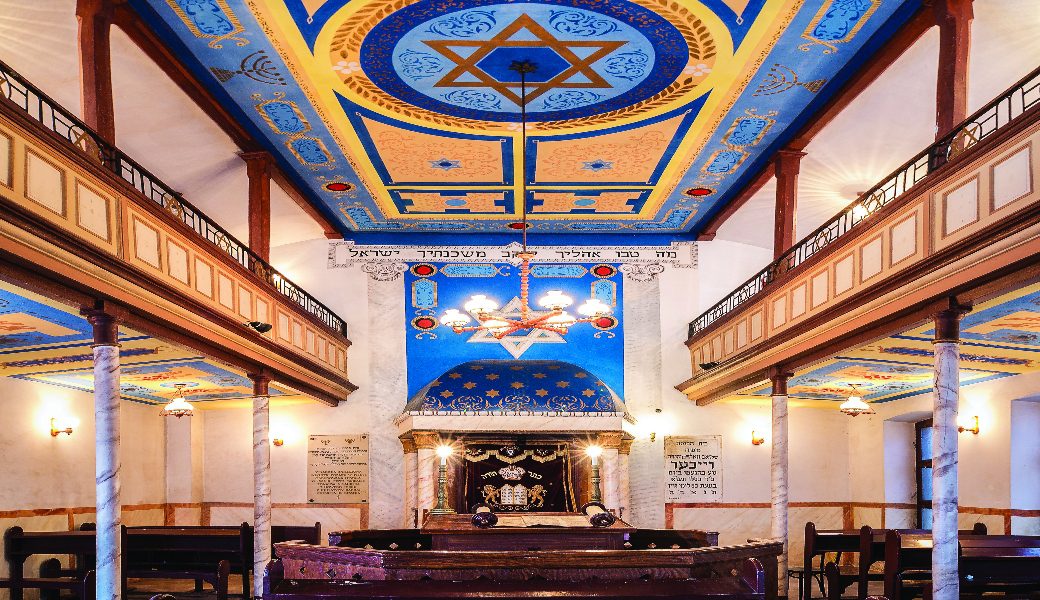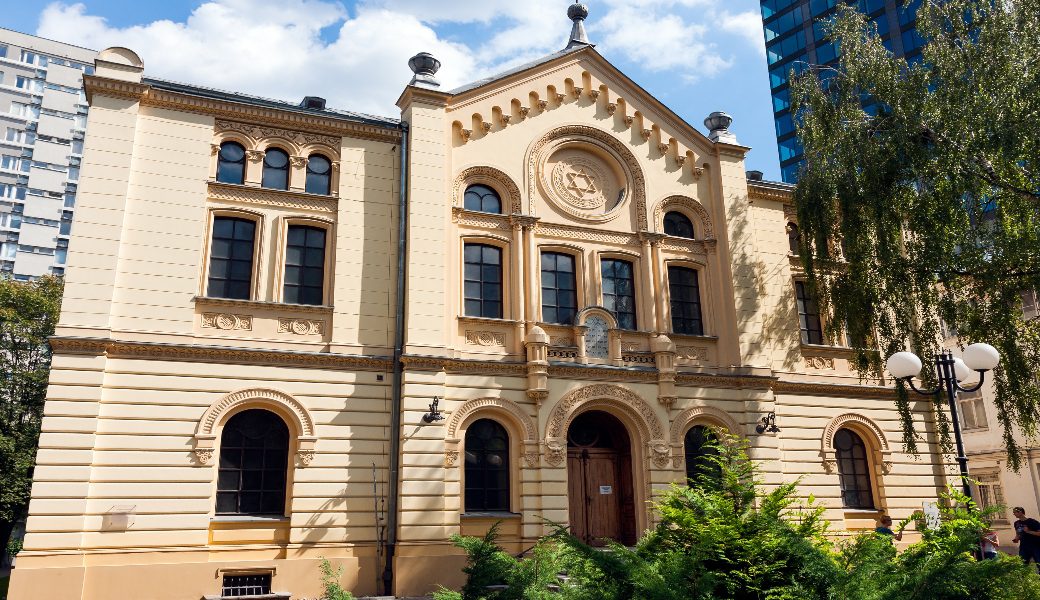The Route of Jewish Heritage in Poland
Introduction
The Route of Jewish heritage in Poland makes the first attempt at a comprehensive approach towards the very complex issues of Jewish heritage in Poland. This viewpoint comes in a cross-section form reflecting on all of the most important phenomena related to what is broadly understood as Jewish Poland and its millennium long history dating back to High Middle Ages.
The Route combines hub cities, perceived as optimal connectors for telling the story of Polish Jewry with its all extraordinary nuances, located in several Polish regions across the country. Linking those 5 hub cities creates a closed trail in a form of a circle.
At the same time, these are the largest Polish metropolitan centers, and allow for a number of sub-routes of regional character to be established in each of the 5 sections.
The idea of the route is to link and cover several themes that are crucial to understanding the complexity and richness of the Polish Jewish Heritage.
It includes such phenomena or terms as: Polin, the Shtetl, the Ashkenazi, the Galitzyaners, the Hassids, the Lodzermensche, and the Jecke Jews (now Western Poland, where a significant German Jewish population had lived since late Middle Ages until the 1930s).
Apart from the abovementioned, the story must also inevitably include the Shoah. Yet it is put in a context of a whole millennium of Jewish life on Polish lands. This is the fact that the Polish Jewry survived, and although numerically small, Jewish life continues in Poland. Members of the new generation serve as the keepers of the tradition and memory of the largest Jewish community which has ever existed throughout two thousand years of the Diaspora in Europe and was once the very heart of Jewish life and culture. Each of the sections of the route will be centered in one of the hubs, large cities with multiple sites, institutions, and rich non-material heritage, namely Warsaw, Lublin, Krakow, Wrocław, and Łódź. Each hub will serve as a focal point for the nearby region, allowing subtours to reach out to the interesting sites as subtours, allowing the more in-depth connection with local Jewish heritage. The full route will make a circle through all the hubs with its start and end in the capital Warsaw. The Polish Jewish community historically formed the core of what is known as the Ashkenazi world. The route explores first and foremost the Ashkenazi heritage. However, Polish Jewish Diaspora had also migrants coming from other Jewish cultural branches which at some point usually melted with the dominant local culture. One of such examples is the city of Zamość (which is a part of the sub-route in the Lublin section) whose originally Sephardic community gradually had been absorbed by the dominating Ashkenazim. The route is designed to reflect on the most important fractions of the Polish Jewish community, usually in combination with one of the hubs. The Polish capital city of Warsaw serves primarily to portray the general outline of Polish Jewish history and specifically of the majority of Polish Jews living once in what’s was now as Russian Poland (the Russian partition). Lublin and its region focus on Polish Jews from the Eastern part of Poland and the former Borderlands (Polish: Kresy) located now in Lithuania, Belarus, and Ukraine, usually living in smaller communities living in small towns know in Jewish tradition as the shtetls. Kraków, formerly a seat of Polish kings and the capital city of Lesser Poland, allows to take a closer look on the Galitzyaners, the specific culture of the Jews from the part of Poland, which was incorporated into the Austro-Hungarian state after the partitions at the end of the 18th century. Next hub is Wroclaw, the capital of lower Silesia a former German city of Breslau. After the Stalin-inspired shift of borders in Central and Eastern Europe agreed during the 1945 Potsdam conference at the end of WW2, it was reincorporated into the Polish state after six centuries long hiatus.
Apart from the abovementioned, the story must also inevitably include the Shoah. Yet it is put in a context of a whole millennium of Jewish life on Polish lands. This is the fact that the Polish Jewry survived, and although numerically small, Jewish life continues in Poland. Members of the new generation serve as the keepers of the tradition and memory of the largest Jewish community which has ever existed throughout two thousand years of the Diaspora in Europe and was once the very heart of Jewish life and culture.
Each of the sections of the route will be centered in one of the hubs, large cities with multiple sites, institutions, and rich non-material heritage, namely Warsaw, Lublin, Krakow, Wrocław, and Łódź. Each hub will serve as a focal point for the nearby region, allowing subtours to reach out to the interesting sites as subtours, allowing the more in-depth connection with local Jewish heritage. The full route will make a circle through all the hubs with its start and end in the capital Warsaw. The Polish Jewish community historically formed the core of what is known as the Ashkenazi world. The route explores first and foremost the Ashkenazi heritage.
However, Polish Jewish Diaspora had also migrants coming from other Jewish cultural branches which at some point usually melted with the dominant local culture. One of such examples is the city of Zamość (which is a part of the sub-route in the Lublin section) whose originally Sephardic community gradually had been absorbed by the dominating Ashkenazim. The route is designed to reflect on the most important fractions of the Polish Jewish community, usually in combination with one of the hubs. The Polish capital city of Warsaw serves primarily to portray the general outline of Polish Jewish history and specifically of the majority of Polish Jews living once in what’s was now as Russian Poland (the Russian partition). Lublin and its region focus on Polish Jews from the Eastern part of Poland and the former Borderlands (Polish: Kresy) located now in Lithuania, Belarus, and Ukraine, usually living in smaller communities living in small towns know in Jewish tradition as the shtetls. Kraków, formerly a seat of Polish kings and the capital city of Lesser Poland, allows to take a closer look on the Galitzyaners, the specific culture of the Jews from the part of Poland, which was incorporated into the Austro-Hungarian state after the partitions at the end of the 18th century. Next hub is Wroclaw, the capital of lower Silesia a former German city of Breslau. After the Stalin-inspired shift of borders in Central and Eastern Europe agreed during the 1945 Potsdam conference at the end of WW2, it was reincorporated into the Polish state after six centuries long hiatus. The Wroclaw hub is designed to tell the story of Jecke (Yekke) from formerly eastern German lands, which are now within Polish borders. It also tells the story of the survivors from prewar Polish Jewish community, many of whom had found refuge and new home in Lower Silesia (although most of them migrated in the next two decades to the West or the newly founded state of Israel). The last hub city, Łódź, is a great location to discuss the Jewish emancipation, and migration from the provincial towns and shtetls to industrial boomtowns of the 19th century, as well as the birth of modern big-city communities, including the issues of acculturation and assimilation. Jewish communities in all 5 hub cities were almost annihilated in the event of WW2 and the Shoah. Despite that, in each of them there are still small communities. The largest and most vibrant is located Warsaw, counting several thousand people and with a growing number of Jewish expats. There are a couple hundred in Krakow, Wrocław, and Łódź, to the smallest one in Lublin. It means that the numbers today are only a small fraction of the prewar numbers (eg. 400K in Warsaw, 250K in Łódź) once among the largest Jewish urban communities worldwide (with Warsaw being only second to NYC prior to 1939, and surpassed by the American metropolis as late as at the turn of the 20th century). The route base, using the 5 hub cities, is designed to portray as much of the historical and current image of Polish Jewry as possible. Therefore, it is not its aim to show all the most interesting objects or to explore specific narrative themes too deeply. The goal, above all, is to present a cross-sectional thematic horizon concerning the history of Polish Jews, or even more broadly, the history of Jews in Polish lands. The task of detailing these narratives will be assigned to potential sub-routes that will be associated with each of the 5 centers with a potential of constant growth and expansion of the network to include new contacts and locations. The first step in settling the route by the Taube Center is, apart from the creation or confirmation on cooperation within the said network of contacts, publication of a set of guidebooks, which will cover all 5 hub cities. The first, The Field Guide to Jewish Warsaw has been published in early 2021, with Łódz and Krakow to follow by mid-2021, and Lublin scheduled for the latter part of the year. Wrocław’s guidebook will be published in 2022. The Taube Center’s field guides are created as a unique combination of historical and geographical information, description of heritage sites, personal stories, and data about the nowadays life of the communities and will correspond with the mapping of the route in the (virtual) space and through the contact network.
Explore the various Walking Tours on this route
History Tour Through the Former Jewish Quarter in Podzamcze
History Tour Along Lubartowska Street
History Tour From Jewish Piaski to Brama Krakowska
History Tour From Brama Krakowska to Wieniawa
History Tour of the Old Town of Lublin
History Tour of the Jewish Cemeteries of Lublin

Helise E. Lieberman
Helise E. Lieberman is the Director of the Taube Center for Jewish Life & Learning Foundation. A former Hillel director, she was the founding principal of the Lauder Morasha Day School in Warsaw and has served as a consultant to the Rothschild Foundation (Hanadiv) Europe, the American Jewish Joint Distribution Committee (JDC) Baltic region, the Westbury Group, and the POLIN Museum of the History of Polish Jews. In June 2015, she was awarded the prestigious Bene Merito Medal by the Polish Minister of Foreign Affairs. Ms. Lieberman was born in the U.S., holds dual citizenship, and has lived in Warsaw since 1994.




